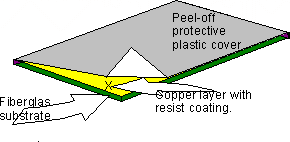Making a two sided Printed
Circuit Board.
Making double sided PC Board.
authored by TheseusRob at Compuserve.com and give me suggestions if this is hard to follow. Return to the PC Board instructions Page using this link.
Here we describe a method that has worked for us many times in the making of a double sided PC board. Clearly, when one is making a PC board with copper on both sides, “registration” is very important. Registration is the alignment of one side with the other; and the two sides MUST be correctly aligned. ("Perfect Registration")
We will describe a process rather than
try to Illustrate it with drawings. We have described the process many
tim
The process requires that you make an
Exposing Envelope out of the two pieces of circuit artwork (top
and bottom of board), which you perhaps refer to as positives or
negatives. For the sake of discussion, we will refer to them as positives.
1. be sure to leave at
least a quarter inch of clear film around the circuit on all sides when
you make your positives. You will need this on at least three of the four
sides.
2. Place the two
positives (top and bottom) together so that they are perfectly aligned.
Then tape the two positives together at the edges with Scotch tape* on
THREE sides so that the fourth side can be the opening of the envelope. It
works best if the two films are identical in size and the tape wraps
around the edges.
3. The
fourth side is the opening of your Exposing Envelope. Working in safe
light, slip the PC board into the envelope. Naturally, you planned
everything well so that the PC board fits nicely into the envelope; a lose
fit is best as you don’t want it so tight that it stretches your tape or
positives.
When using a
Datak precoated (Premier series) double sided PC board, you’ll remove the
protective plastic cover from both sides and discard the plastic. Be sure
to peel the plastic off as pulling up on it can take some of the resist
with it.
4. The board will
have to be held VERY securely inside the envelope; do this by allowing the
PC board to stick out of the envelope on that one open side. Let the board
stick our about 1/4″ and tape the board to the envelope on both sides;
tape neatly! This will prevent movement and keep everything nicely
“registered”.
When the
board is securely taped to the envelope, expose each side for the
recommend time and then develop the board. Turn the board and be
sure both sides are completely developed just as you would for a single
sided PC board. (I use my fingers; but the company says to wear a thin
rubber glove.)
Notes: A simple
process, no? About the only Caveat is to be sure not to run tape on top of
the circuit patterns as it can block enough light during exposure to
(possibly) cause a problem. You’ll soon learn to allow room for tape, trim
the envelope opening and leave a bit extra on a board to tape at the
opening. Minor things.
Don’t make the envelope too tight. Shoot for 1/4″ on all three sides that
will be taped.
Sometimes, this author trims the film for the “bottom” side larger than the film positive for the top side. It is easier to tape and hold good registration during taping if the piece of film on the bottom is a bit larger than the top piece. However, if the top and Bottom side film positives are of equal size (as mentioned above), it sometimes makes it easier to handle the finished envelope. Then you have to put tape on the top film an wrap it around the edges without the two films travelling and messing up registration. For bigger boards (6 X 6 on up), I am forced to use the “equal size” films as thing seem to work more easily.
QUESTIONS? SEND ME A NOTE: TheseusRob at Compuserve.com and I’ll try to get back to you right away.